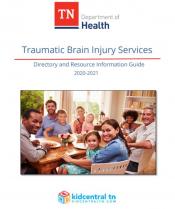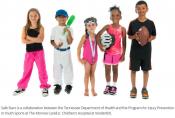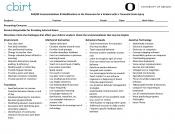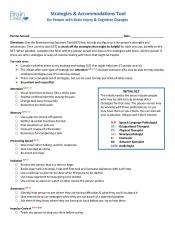 Concussion and Brain Injury in Students, Who needs to know? Concussion is a mild Traumatic Brain Injury (TBI). A TBI during childhood may affect brain development. Children may experience changes in their health, thinking, and behavior that affect learning, self-regulation, and social participation, all of which are important to becoming a productive adult. Proactive teamwork, quick response and effective communication are essential to help a child after brain injury to Return to Learn and Return to Play. cdc.gov/traumatic-brain-injury Word Document File
Concussion and Brain Injury in Students, Who needs to know? Concussion is a mild Traumatic Brain Injury (TBI). A TBI during childhood may affect brain development. Children may experience changes in their health, thinking, and behavior that affect learning, self-regulation, and social participation, all of which are important to becoming a productive adult. Proactive teamwork, quick response and effective communication are essential to help a child after brain injury to Return to Learn and Return to Play. cdc.gov/traumatic-brain-injury Word Document File
 Go Back to Play After a Concussion: This is a concussion return to play manual created for student-athletes who do not have access to an athletic trainer to guide them through the Return To Learn (RTL) process. This manual follows the RTP process required by the Tennessee state concussion law. This resource is a way for parents or coaches to track and document the progress of their athletes. Vanderbilt Sports Concussion Center
Go Back to Play After a Concussion: This is a concussion return to play manual created for student-athletes who do not have access to an athletic trainer to guide them through the Return To Learn (RTL) process. This manual follows the RTP process required by the Tennessee state concussion law. This resource is a way for parents or coaches to track and document the progress of their athletes. Vanderbilt Sports Concussion Center
 TN TBI Services Directory & Resource Guide: The Tennessee Department of Health Traumatic Brain Injury Service Directory and Resource Information Guide was designed to assist in locating programs, organizations, agencies, and services available across the state of Tennessee and the nation.
TN TBI Services Directory & Resource Guide: The Tennessee Department of Health Traumatic Brain Injury Service Directory and Resource Information Guide was designed to assist in locating programs, organizations, agencies, and services available across the state of Tennessee and the nation.
 TN Safe Stars Initiative: The Safe Stars initiative recognizes youth sports leagues throughout Tennessee for providing the highest level of safety for their young athletes. Safe Stars consists of 3 levels: gold, silver, and bronze, and involves implementation of policies around topics such as concussion education, weather safety and injury prevention. Safe Stars’ goal is to provide resources and opportunities for every youth sports league to enhance their safety standards. The criteria for achieving recognition as a Safe Stars league has been developed by a committee of health professionals dedicated to reducing sports-related injuries among youth. Eamil Safe Stars to learn more at safestars.health@tn.gov.
TN Safe Stars Initiative: The Safe Stars initiative recognizes youth sports leagues throughout Tennessee for providing the highest level of safety for their young athletes. Safe Stars consists of 3 levels: gold, silver, and bronze, and involves implementation of policies around topics such as concussion education, weather safety and injury prevention. Safe Stars’ goal is to provide resources and opportunities for every youth sports league to enhance their safety standards. The criteria for achieving recognition as a Safe Stars league has been developed by a committee of health professionals dedicated to reducing sports-related injuries among youth. Eamil Safe Stars to learn more at safestars.health@tn.gov.
TN Secondary School Athletic Association (TSSAA): Concussion Return to Play Form, in English and in Español.
National Collegiate Athletic Association (NCAA) is a member-led organization dedicated to the well-being and lifelong success of college athletes.
The HEADS UP to Schools: Online Concussion Training for School Professionals is designed to help classroom teachers (grades K-12), school administrators, paraprofessionals, teachers' aides, and other staff who work with students understand:
- How a concussion may affect a student’s learning, emotions, and behavior.
- How to identify and monitor signs and symptoms of concussion.
- How to help students successfully return to school and recover from a concussion.
This free training will take about 45-60 minutes to complete. It features easy-to-follow information with knowledge checks and illustrated case studies that showcase a variety of scenarios to help you apply the information presented and achieve the key learning objectives of the course.
Check out the CDC HEADS UP trainings on concussion:
- Training for coaches
- Training for healthcare providers
- Videos on concussion safety
- Graphics and infographics
The HEADS UP to Athletic Trainers: Online Concussion Training was developed through a partnership between the Centers for Disease Control and Prevention (CDC) and the National Athletic Trainers' Association (NATA) to share the latest guidance on concussion prevention, evaluation, and management. Athletic trainers have the opportunity to earn 2 continuing education credits through NATA after completing the training.
The HEADS UP to Athletic Trainers: Online Concussion Training was developed through a partnership between the Centers for Disease Control and Prevention (CDC) and the National Athletic Trainers' Association (NATA) to share the latest guidance on concussion prevention, evaluation, and management.
Athletic trainers have the opportunity to earn 2 continuing education credits through NATA after completing the training.

CDC HEADS UP for Specific Audiences: Health Care Provider,Youth Sports League, Youth Sports Coaches, Parent, Athlete, Sports Official, School Sports: Coach, Parent, Athlete, Sports Official, School: School Nurse, Teacher, Parent.

 CBIRT: 504/IEP Accommodations & Modifications in the Classroom for a Student with a TBI: Each section is broken down into helpful categories - developed by the Center on Brain Injury Research & Training (CBIRT)
CBIRT: 504/IEP Accommodations & Modifications in the Classroom for a Student with a TBI: Each section is broken down into helpful categories - developed by the Center on Brain Injury Research & Training (CBIRT)
 CBIRT Sample Goals: Sample goals for students with TBI.
CBIRT Sample Goals: Sample goals for students with TBI.

 Personal Guide for Everyday Living: A tool to help people with TBI (especially mild TBI) better understand what conditions make things harder and what the person can do about it. Best if used as part of a conversation with the clinician. English and in Español.
Personal Guide for Everyday Living: A tool to help people with TBI (especially mild TBI) better understand what conditions make things harder and what the person can do about it. Best if used as part of a conversation with the clinician. English and in Español.
Yearly screening: Recommend using the HELPS Brain Injury Screening Tool OR add questions to the annual health history intake forms.
HELPS Brain Injury Screening Tool: The original HELPS TBI screening tool was developed by M. Picard, D. Scarisbrick, R. Paluck, 9/91, International Center for the Disabled, TBI-NET, U.S. Department of Education, Rehabilitation Services Administration, Grant #H128A00022. The Helps Tool was updated by project personnel to reflect recent recommendations by the CDC on the diagnosis of TBI.
- H - Have you ever Hit your Head or been Hit on the Head?
- E - Were you ever seen in the Emergency room, hospital, or by a doctor because of an injury to your head?
- L - Did you ever Lose consciousness or experience a period of being dazed and confused because of an injury to your head?
- P - Do you experience any of these Problems in your daily life since you hit your head?
- S - Any significant Sicknesses?
![]() Symptom Tracker: Track Symptoms, pain level changes, what provokes and what helps. Good information to take back to the healthcare provider.
Symptom Tracker: Track Symptoms, pain level changes, what provokes and what helps. Good information to take back to the healthcare provider.
 Concussion-Brain Injury Alert & Monitoring Form: For use in academic, school nurse or case manager file to serve as a reminder of the TBI. Also alerts others who may start working with the child.
Concussion-Brain Injury Alert & Monitoring Form: For use in academic, school nurse or case manager file to serve as a reminder of the TBI. Also alerts others who may start working with the child.

 Brainstorming Solutions Tool: Helpful template for gathering information on person's skills and challenges to facilitate development of solutions. Great for direct service providers, students and new hires.
Brainstorming Solutions Tool: Helpful template for gathering information on person's skills and challenges to facilitate development of solutions. Great for direct service providers, students and new hires.
 Strategies & Accommodations Tool: Use the Brainstorming Solutions Tool (BST) first, to help you figure out the person’s strengths and weaknesses. Then use this tool (SAT) to check off the strategies that might be helpful for each area you identify on the BST. When possible, complete this form with the person served and discuss the strategies with them. Ask the person if there are other strategies or ways of communicating with them that might be helpful.
Strategies & Accommodations Tool: Use the Brainstorming Solutions Tool (BST) first, to help you figure out the person’s strengths and weaknesses. Then use this tool (SAT) to check off the strategies that might be helpful for each area you identify on the BST. When possible, complete this form with the person served and discuss the strategies with them. Ask the person if there are other strategies or ways of communicating with them that might be helpful.



